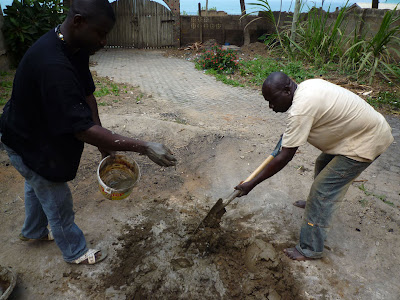I will miss Ghana and all of the incredible people I have
met there who were so welcoming and friendly beyond compare. A special thanks
to the following people for making my trip so exceptional:
Francis Boateng – a fun, upbeat, politically-minded, and
talented artist who has great hopes and dreams for Ghana. I was lucky to have
Francis along with me during most of my travel from Accra, and he introduced me
to potters and friends all over the country. He taught me so much about Ghana beyond pottery and art. I will miss our conversations on just about
everything.
James Kafui Ahiave – It was an honor to work with such a gifted, humble, and patient person. Special thanks to James for befriending me and teaching me cement
sculpting and ceramic firing methods. One of the nicest, most genuine people I
have ever met.
Aba (Ellie Schimelman) – A former teacher from Boston, Aba lives an important and unconventional life, dedicating the past 20 years to
helping the children of Nungua. She was the bridge that connected me to
everything in Ghana. I owe her a debt of gratitude for helping me plan my trip to Ghana, arranging for me to meet potters and artists.
Talk True – (Chef from Aba House) I already miss his food, and
even more I miss his friendly and honest personality. Talk True, I hope you
write a cookbook so I can try to reproduce your ginger hibiscus iced tea, red
red, cabbage stew, fried plantains, banana bread, and African pizza.
Rally Debrah – represents something I found often in Ghana – people
juggling a way to pursue their careers while simultaneously dedicating
themselves to some kind of public service for the community. Aside from being a
professor at NKUST and other ambitious projects, she has started a
non-profit to help children go to school, and women from Northern Ghana to learn
artistic skills to make clothes. I hope we can stay in touch.
Ben Kwao Adipah – art education consultant and former Ghanaian
art teacher - your kindness, conversations with me about Ghana and art
education, and your generosity were greatly appreciated. I wish I had much more
time to learn from your ideas and experience.
To all the potters and artists who invited me into their homes and studios, and spent countless hours sharing their knowledge and techniques with me, I am forever grateful.









































